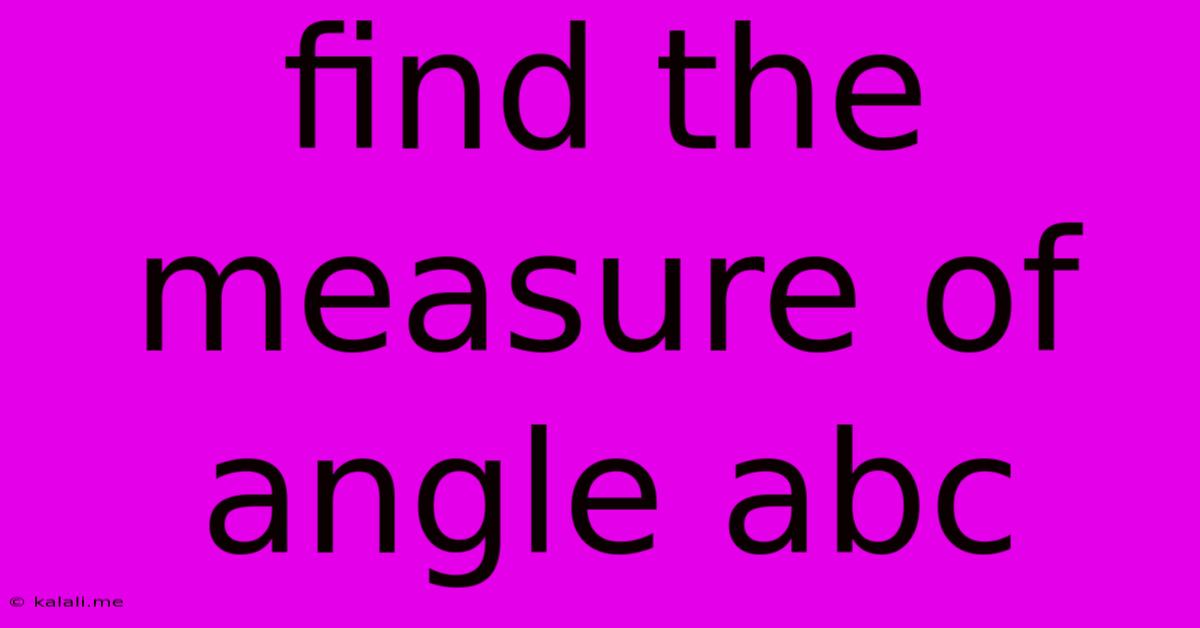Find The Measure Of Angle Abc
Kalali
Jun 14, 2025 · 3 min read

Table of Contents
Finding the Measure of Angle ABC: A Comprehensive Guide
Finding the measure of angle ABC hinges on understanding the properties of triangles, lines, and angles. This article will explore various scenarios and techniques to determine the measure of this angle, catering to different levels of mathematical understanding. Whether you're dealing with simple geometric shapes or more complex diagrams, we'll equip you with the tools to solve for angle ABC.
Understanding the Basics: Angles and Triangles
Before diving into specific examples, let's refresh some fundamental concepts. An angle is formed by two rays sharing a common endpoint (the vertex). Angles are measured in degrees (°). A triangle is a closed two-dimensional shape with three sides and three angles. The sum of the angles in any triangle always equals 180°. This crucial property forms the foundation for many angle calculations. We'll also utilize concepts like complementary angles (two angles whose sum is 90°) and supplementary angles (two angles whose sum is 180°). Understanding these relationships is key to finding the measure of angle ABC in various contexts.
Scenario 1: Angle ABC within a Triangle
If angle ABC is part of a triangle, and you know the measures of the other two angles, finding the measure of angle ABC is straightforward. Simply subtract the sum of the other two angles from 180°.
Example: In triangle ABC, angle BAC measures 50° and angle BCA measures 60°. Therefore, angle ABC = 180° - (50° + 60°) = 70°.
Scenario 2: Angle ABC as a Part of Intersecting Lines
When angle ABC is formed by intersecting lines, you can leverage the properties of vertical angles and adjacent angles. Vertical angles are opposite angles formed by intersecting lines; they are always equal. Adjacent angles are angles that share a common vertex and side; if they form a straight line, their sum is 180°.
Example: Lines DE and FG intersect at point B, forming angle ABC. If angle ABD measures 110°, then angle ABC (its vertical angle) also measures 110°. Alternatively, if angle DBC measures 70°, then angle ABC (its supplementary angle) measures 180° - 70° = 110°.
Scenario 3: Angle ABC in Isosceles or Equilateral Triangles
Isosceles and equilateral triangles possess unique properties that simplify angle calculations. An isosceles triangle has two equal sides and two equal angles. An equilateral triangle has three equal sides and three equal angles (each measuring 60°).
Example: If triangle ABC is an isosceles triangle with AB = AC, and angle BAC measures 40°, then angles ABC and ACB are equal. Since the angles in a triangle sum to 180°, we have: 2 * angle ABC = 180° - 40° = 140°. Therefore, angle ABC = 70°. If triangle ABC were equilateral, angle ABC would automatically be 60°.
Scenario 4: Using Trigonometric Functions (More Advanced)
For more complex scenarios involving right-angled triangles, trigonometric functions (sine, cosine, tangent) can be employed to determine the measure of angle ABC. This typically involves knowing the lengths of at least two sides of the triangle.
Conclusion: A Versatile Approach to Angle Calculation
Finding the measure of angle ABC relies heavily on understanding fundamental geometric principles and selecting the appropriate method based on the given information. By applying the techniques outlined above—leveraging the properties of triangles, intersecting lines, and, when necessary, trigonometry—you can effectively solve a wide range of angle measurement problems. Remember to always carefully analyze the diagram and utilize the relevant geometric properties to arrive at the correct solution.
Latest Posts
Latest Posts
-
What Are The Units For Measuring Heat Energy
Jun 15, 2025
-
Select The Statement That Best Describes Old World Monkey
Jun 15, 2025
-
Does A Rhombus Have A Line Of Symmetry
Jun 15, 2025
-
Which Of The Following Are Flammable Gases
Jun 15, 2025
-
Which Of The Following Is A Nonrenewable Device
Jun 15, 2025
Related Post
Thank you for visiting our website which covers about Find The Measure Of Angle Abc . We hope the information provided has been useful to you. Feel free to contact us if you have any questions or need further assistance. See you next time and don't miss to bookmark.